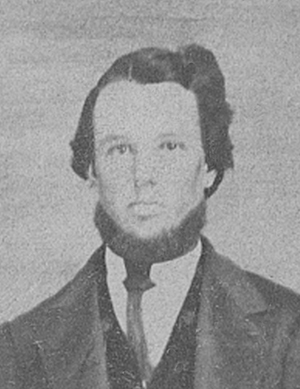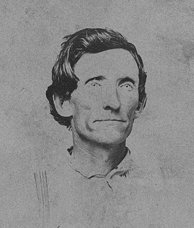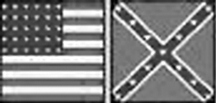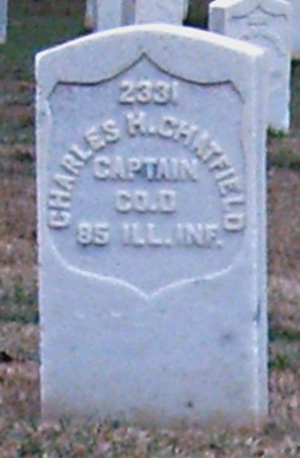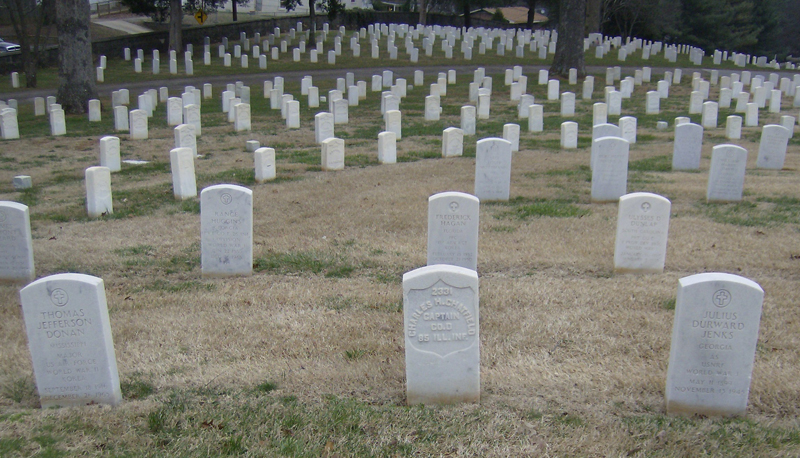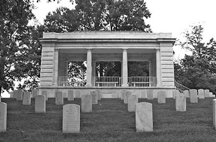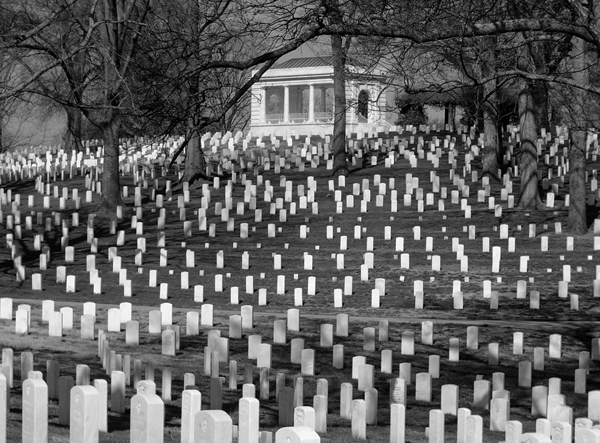8. Charles Henry Chatfield (#2)
FAMILY LINE AND HISTORY
Charles Henry Chatfield(#2)
- 3rd of 4 children of Levi Tomlinson Chatfield & Lovina Mastick
- Born: Oct 3, 1840, Middlefield, Geauga County, Ohio
- Died: Jun 27, 1864 (age 23), in the Battle of Kennesaw Mountain, Cobb County, Georgia
- Buried: Marietta National Cemetery in Marietta, Cobb County, Georgia
- Military Service: Kansas Border War ; Civil War: Union Army, Captain, Distinguished Service
- Never married, no children
Charles Henry Chatfield(#2) Timeline
History, Census Records, Military Records, Historical Notations:
Oct 3, 1840: Birth of Charles Henry Chatfield (#2), 3rd child of Levi Tomlinson Chatfield & Lovina Mastick, in Middlefield, Geauga County, Ohio.
Nov 11, 1848: Death of father, Levi Tomlinson Chatfield (age 35), of Bright’s disease in Middlefield, Geauga County, Ohio. Levi is buried in the Middlefield (Village) Cemetery in Middlefield, Geauga County, Ohio. Levi’s four children are Isaac Willard Chatfield (age 12), Clark Samuel Chatfield (age 10), Charles Henry Chatfield(#2) (age 9), and Ellen Chatfield (age 2).
| Oct 31, 1850: Federal Census for Mason County, Illinois: |
| Levina Chatfield: age 40, born Ohio (note: error, born Vermont) Willis Chatfield: age 15, born Ohio (note: Isaac Willard Chatfield) |
Clark Chatfield: age 12, born Ohio
Charles Chatfield: 10, born Illinois
Ellen Chatfield: age 4, born Illinois
| 1855: State Census for Mason County, Illinois: |
| L. Chatfield: head of household (Lovina Chatfield) 3 males (age 10-20) (sons, Isaac, Clark and Charles) |
1 female (age 1-10) (daughter Ellen)
1 female (age 40-50) (mother Lovina)
Apr 20, 1858: Death of mother, Lovina Chatfield (age 48), in Bath, Mason County, Illinois. Lovina is buried in Bath Cemetery in Bath, Mason County, Illinois. Lovina leaves behind Isaac Willard (age 21), Clark Samuel (age 20), Charles Henry(#2) (age 17), and Ellen (age 11)
May 20, 1858: Charles Henry Chatfield’s oldest brother, Isaac Willard Chatfield marries Eliza Ann Harrington in Havana, Mason County, Illinois. Isaac and Eliza take on the raising of Charles (age 17) and his sister Ellen (age 11). Charles travels with Isaac & Eliza to Kansas, and stays on to fight in the Border War when Isaac and his family return to Illinois.
Sep 12, 1858: Charles Henry Chatfield’s older brother, Clark Samuel Chatfield marries Louisa Tankersley in Havana, Mason County, Illinois.
1859: Charles Henry Chatfield (age 18) serves in the final year of the Border War in Kansas.
| BORDER WAR |
| Border War (1854–1859) The Kansas-Nebraska Act of 1854, which allowed local voters to decide whether Kansas would be a slave state or a free state, prompted emigration from the Northeast of antislavery groups, the arrival of squatters and speculators, and the presence of an adventurous element recruited from both North and South. Ideological differences over slavery and recurring personal altercations led proslavery and free-state groups to organize regulating associations and guerrilla bands. Lynching, horse stealing, pillaging, and pitched battles marked the years from 1854 to 1859 and inspired the name “Bleeding Kansas” for the territory. The first eighteen months of settlement witnessed sporadic shootings, killings, and robberies. Major conflict terminated in 1859, albeit sporadic disorders continued until the Civil War. |
| On-line source: Encyclopedia of American History, Answers.com, http://www.answers.com/topic/border-war |
1860: Charles Henry Chatfield (age 19) rejoins Isaac’s family in Bath, Mason County, Illinois.
These unidentified pictures were in the Chatfield (Tuck) family photo album on the same page with others in the four other Carte de Visite pictures of the Chatfield family. Tis possible that one of these may be Charles.
| Aug 31, 1860: Federal Census for Bath, Mason County, Illinois: |
| Willard Chatfield: age 23, Farm Keeper, Value of Personal Estate $100, born Ohio (head) Eliza Chatfield: age 19, born Iowa (wife, age 20) |
Clara E. Chatfield: age 1, born Kansas (daughter Ella Clara)
Ellen C. Chatfield: age 14, born Illinois, attended school within the year (sister)
Charles Chatfield: age 19, laborer, Value of Personal Estate $100, born Ohio (brother)
Apr 12, 1861: Beginning of the American Civil War (also known in the South as The War of the Rebellion)
| AMERICAN CIVIL WAR |
| The American Civil War (1861–1865) was a major war between the United States (the “Union”) and eleven Southern states which declared that they had a right to secession and formed the Confederate States of America, led by President Jefferson Davis. The Union, led by President Abraham Lincoln and the Republican Party, which had opposed the expansion of slavery into territories owned by the United States, rejected any right of secession. Fighting commenced on April 12, 1861, when Confederate forces attacked a United States (federal) military installation at Fort Sumter in South Carolina, the first state to secede.By 1864, long-term Union advantages in geography, manpower, industry, finance, political organization and transportation were overwhelming the Confederacy. Grant fought a number of bloody battles with Lee in Virginia in the summer of 1864. Lee’s defensive tactics resulted in extremely high casualties for Grant’s army, but Lee lost strategically overall as he could not replace his casualties and was forced to retreat into trenches. In 1865, the Confederacy collapsed after Lee surrendered to Grant. |
All slaves in the Confederacy were freed by the Emancipation Proclamation. Slaves in the border states and Union-controlled parts of the South were freed by state action or by the Thirteenth Amendment.
The full restoration of the Union was the work of a highly contentious postwar era known as Reconstruction. The war produced about 970,000 casualties (3% of the population), including approximately 620,000 soldier deaths—two-thirds by disease. The war accounted for more casualties than all other U.S. wars combined. The causes of the war, the reasons for its outcome, and even the name of the war itself are subjects of lingering controversy even today. The main results of the war were the restoration and strengthening of the Union (mainly by permanently ending the issue of secession), and the end of slavery in the United States. About 4 million black slaves were freed in 1865. Based on 1860 census figures, 8% of all white males aged 13 to 43 died in the war, including 6% in the North and an extraordinary 18% in the South.On-line source: http://en.metapedia.org/wiki/American_Civil_War
| Civil War Records, Chatfield Brothers: |
| Chatfield, Chas. H., Bath |
- Enlisted Company K. May 25, 1861
- Wounded at Fort Donelson
- Discharged. June 13, 1862
- Captain, Co “D” 85th Illinois Infantry
- RESIDENCE: Bath, Mason Co., Illinois
- AGE: 21
- HEIGHT: 5’8 1/2
- HAIR: Black
- EYES: Dark
- COMPLEXION: Dark
- MARITAL STATUS: Single
- OCCUPATION: Clerk
- NATIVITY: Burton, Geauga Co., Ohio
- JOINED: JUL 18, 1862 Mason County, Illinois by Cpt. Houghton, Period 3 YRS
- MUSTER: AUG 27, 1862 Peoria, IL
CHATFIELD, Charles H 2nd Lt. Bath Aug 27, 1862 Promoted [Dec 21, 1862]
CHATFIELD, Charles H 1st Lt. Bath Jan 21, 1863 Promoted [Dec 27, 1863]
CHATFIELD, Charles H Captain Bath Feb 29, 1864 Killed Jun 27, 1864
AMERICAN CIVIL WAR
May 25, 1861: Charles Henry Chatfield (age 20) enlists in the Union army as a Private in Company K, 17th Illinois Volunteer Infantry.
Jul 23, 1861: Charles’ brother, Clark Samuel Chatfield (age 21), enlists in the Union army as a Corporal, Company C, 2nd Cavalry, Volunteer Regiment, Illinois; promoted to Full Private.
Aug 12, 1861: Charles’ brother, Isaac Willard Chatfield (age 25) enlists in the Union army, Sergeant 1st Class, Co E. 27th Infantry Volunteer Reg., Illinois. Company “E” 27th Illinois Infantry
CHATFIELD, Isaac W, 1st Serg. Bath Aug 16, 1861, Promoted 2nd Lt. Aug 27, 1861
CHATFIELD, Isaac W, 2nd Lt. Bath, Resigned July 19, 1863Source: Illinois Military Units in the Civil War, Published by Civil War Centennial Commission of Illinois, Springfield, 1962, and comparisons with USGS place/name data base
| History of Menard & Mason Counties |
| SEVENTEENTH REGIMENT, ILLINOIS The Seventeenth Regiment of Infantry was mustered into service at Peoria, Ill., on the 24th of May, 1861, and Leonard F. Ross elected Colonel. The first volunteers from Mason County went into this regiment, and were organized into Company K. The regiment left camp for Alton on the 17th of June. Late in July, it moved to St. Charles, Mo., and the next day went to Warrenton, Mo., and remained two weeks, Company A being detailed as body-guard to Gen. Pope, with headquarters at St. Charles. The regiment went from Warrenton to St. Louis, and from thence to Bird’s Point, Mo., where it remained some weeks on garrison duty, and proceeded to Sulphur Springs Landing; from there, by way of Pilot Knob and Ironton, to Fredericktown, Mo., in pursuit of Gen. Prentice’s command at Jackson, Mo.From Jackson, Mo., the regiment went over into Kentucky to assist in the construction of Fort Holt; from there to Elliott’s Mills, and back to Fort Holt, and thence back to Cape Girardeau, Mo., in pursuit of Jeff Thompson’s forces. On the 21st of October, 1861, the regiment met Thompson’s forces at Fredericktown, Mo., where the regiment had its first battle with the enemy… all of Company K. Returning to Cape Girardeau, the regiment went on provost duty until February, 1862, when they proceeded to Fort Henry, and from there to Fort Donelson, where they participated in the Fort Donelson battle, and suffered heavy loss in killed and wounded. |
| Source: 1879 History of Menard & Mason Counties, Published by: O.L. Baskin & Co., Historical Publishers, 186 Dearborn Street, Chicago, Illinois, www.illinoisancestors.org/mason/ |
Feb 13, 1862: Charles Henry Chatfield is severely wounded at the battle of Fort Donelson. (The battle was fought Feb 12 through Feb 16, 1862 in Stewart County, Tennessee). Isaac W. Chatfield’s wife, Eliza (Harrington) Chatfield, serves as a nurse during this battle.
Jun 13, 1862: Charles H. Chatfield is discharged on account of wounds and returns to Bath. He assists in recruiting Company D, 85th Illinois Infantry, and is elected second lieutenant at the organization of the company.
| Charles Henry Chatfield — Civil War Military Record |
| SERVICE RECORD Civil War Companies Organized in Mason County, Illinois (1,531 served) Company “K” 17th Illinois Infantry |
Name: CHATFIELD, Charles H
Rank: Private
Residence: Bath
Date of Muster: May 25, 1861
Remarks: Discharged Jun 13, 1862; wounds
Company “D” 85th Illinois Infantry
Dec 21, 1862: Charles Henry Chatfield is promoted to First Lieutenant.
Dec 27, 1863: Charles Henry Chatfield is promoted to Captain.
Feb 29, 1864: Charles joins Union Army at Camp McCaffee, Georgia; joined By GOV OF Illinois for a period of 3 years. Mustered at Chattanooga, Tennessee
Jun 27, 1864: Death of Captain Charles Henry Chatfield (age 23), killed in battle on the west side of the mountain in Battle of Kennesaw Mountain (near Marietta), Cobb County, Georgia.
| KENNESAW MOUNTAIN |
| A small group of mountains rise in Cobb County, Georgia. The tallest and northernmost, Kennesaw Mountain, is known locally as “Big Kennesaw” and rises some 800 feet above the Georgia Piedmont. Due south is Little Kennesaw Mountain, separated from Big Kennesaw by a deep gap. Little Kennesaw drops precipitously to Pigeon Hill, named for the carrier pigeon that once darkened the Georgia skies. South of Pigeon Hill the mountains become a low ridge, culminating at a point known today as Cheatham Hill. It was here on July 27, 1864, that William Tecumseh Sherman attacked Joseph E. Johnston in what turned out to be the greatest Union loss during the Atlanta Campaign. |
| Online source: Georgia’s Blue and Gray Trail Presents America’s Civil War, http://blueandgraytrail.com/event/Kennesaw_Mountain |
| HISTORY of the 85th ILLINOIS VOLUNTEERS |
| CHAPTER XV. (pgs 174 – 193) June 1864 – July 1864 In the evening, after darkness had set in, the enemy made a noise which the men supposed to be preparations for a countercharge, but it was probably a ruse. Instantly the men were on their feet, when a volley was fired by the enemy which killed Captain Charles H. Chatfield, of Company D, and several enlisted men of the Eighty-fifth. About this time entrenching tools arrived, and a permanent line of works erected, the flanks of the brigade being slightly retired to meet the connecting lines on the right and left. And night and day the fight was continued over the narrow strip of ground, the firing being almost constant, and the men at all times ready to repel a countercharge, an emergency that might arise at any moment.CHAPTER XXX. (pgs 393 – 407)Company D was enrolled by Dr. Charles W. Houghton, residing at Bath, Mason county, and was recruited between July 18 and August 8, 1862. At the organization of the company, the following commissioned officers were elected: Charles W. Houghton, captain; Comfort H. Ramon, first lieutenant; and Charles H. Chatfield, second lieutenant. This company was mustered in with 95 officers and men, of whom 5 were killed in action, 3 died of wounds, 1 was accidentally killed and 15 received wounds in battle which did not prove fatal while in the service, 13 died of disease, 22 were discharged for disability, 1 was transferred, and 40 officers and men were mustered out with the regiment. Under the careful training of Lieutenant Chatfield this company became very proficient in the skirmish drill, and upon all occasions performed its duty with zeal and energy. The following is |
THE COMPANY ROSTER (pg 393).
CAPTAIN CHARLES H. CHATFIELD was born in Middlefield, Geauga county, Ohio, October 3, 1840, removed with his parents to Illinois in 1843, and settled on a farm in Mason county. After making a trip to Pike’s Peak, in 1859, he settled near Fort Scott, Kansas, and served six months in the Border War. He returned to Illinois in 1860, and was a clerk in Bath when he enlisted as a private May 25, 1861, in Company K, Seventeenth Illinois Volunteer Infantry, and was severely wounded at the battle of Fort Donelson, February 13, 1862. He was discharged on account of wounds June 15, 1862, returned to Bath, and assisted in recruiting Company D, and was elected second lieutenant at the organization of the company. He was a splendid drillmaster and was filled with soldierly pride. General Sheridan once said to Colonel Moore, “You must hold that young lieutenant back – he is too anxious for a fight.” He was promoted first lieutenant December 21, 1862, and to be captain December 27, 1863. He commanded his company from the latter date, until killed in the assault on Kennesaw Mountain, Georgia, June 27, 1864. His remains are buried at No. 2331, in the national cemetery at Marietta, Ga.Source: Compiled and published under the Auspices of the Regimental Association, by Henry J. Aten, First Sergeant Company G, Member of the Society of the Army of the Cumberland, Hiawatha, Kansas, 1901. Submitted on-line by Janine Crandell, transcribed by Ron Manroe. www.iltrails.org/fulton
Jun 27, 1864: Burial of Captain Charles Henry Chatfield at the Marietta National Cemetery, Section C, Site 2331, Marietta, Cobb County, Georgia. Charles is buried near two other soldiers from his same regiment killed in battle at Kennesaw Mountain, Austin Walker and D.A. Brands.
May 1865: End of the American Civil War. Over 3 million soldiers battle in the Civil War and more than 600,000 die, two-thirds by disease.
1866: The Marietta National Cemetery is established in 1866 to provide a resting place for the nearly 10,000 Union dead from Sherman’s Atlanta Campaign.
Marietta National Cemetery.
| PATRIOTS IN DISGUISE: Women Warriors of the Civil War |
| Due to her exploits at the battle of Shiloh, April 6-7, 1862, Belle Reynolds was commissioned as a major by the governor of Illinois. In the summer of 1861 her husband had joined the 17th Illinois Infantry as a lieutenant. (Note: the 17th Illinois Infantry is the same company in which Charles Henry Chatfield was enlisted.) Throughout the fall and winter of 1861-1862, Belle stayed with the regiment, sometimes riding in an army wagon or ambulance, and sometimes on a mule. At other times she marched in the ranks with the soldiers, carrying a musketoon on her shoulder.In February, 1862 Grant captured Fort Henry and Fort Donelson (Note: Eliza Chatfield was serving here as a nurse), opening middle Tennessee to invasion by Union Forces. On April 6, threatened by Grant’s army near Corinth, the Confederates attacked the Union camp at Pittsburg Landing [Shiloh], Tennessee. (Note: Eliza also served at Shiloh) |
Belle wrote in her journal for April 4th: “The long roll has called the regiment out, and we know not what an hour may bring forth. Pickets have been driven in, and skirmishing is going on at the front. Distant musketry and the rumbling of artillery past my tent give the situation a look of reality which I had not dreamed of an hour ago. Although so near the enemy’s lines, we feel no fear. Mrs. N. and myself are the only ladies in camp, and our tents are adjoining.”
The battle broke full force at daybreak Sunday, April 6th, lasting through the next day after an overnight interruption. A sudden attack in force in the early morning hours caused half-awake Union troops to flee their camps. In her next journal entry dated April 17th, Belle reported her experiences when the Union camps were overrun: “At sunrise we heard the roll of distant musketry… [About an hour later] while preparing breakfast over the campfire, we were startled by cannonballs howling over our heads.
“Shells were bursting in every direction about us. Tents were torn in shreds, and the enemy, in solid column, was seen coming over the hill in the distance.” As they fled, they saw cavalry soldiers forming on the parade ground near the camp. “Balls were flying and shells bursting among the terrified horses and fearless riders.”
Before they had gone far, Belle and Mrs. N. came upon ambulances from which the wounded were being carried out and laid on the ground. “We stopped, took off our bonnets, and prepared to assist in dressing their wounds,” she said. But an orderly dashed up, shouting orders to move the wounded immediately to the river. The rebels were closing in, and they were not safe where they were. Making their way to the river, Belle and her friend boarded the EMERALD, one of the steamers that served as Captain Norton’s headquarters. Soon the wounded came pouring in, and they were busy for the next thirty-six hours doing what they could to comfort the soldiers.
By nighttime, the EMERALD alone had 350 wounded aboard. All day long they heard the thunder of artillery, and spent bullets fell like leaden hail on the deck of the boat. Shells directed at the ammunition ship nearby whirled over their heads. Near sunset the retreating Union army crowded the scene, many seeking shelter on the already crowded boats, some swimming to the opposite shore. Just as it seemed their position would be overrun, the gunboats LEXINGTON and TYLER steamed upriver and unleashed a deadly fire on the Confederates. Union reinforcements could be seen on the opposite shore, approaching at the double-quick. As the transports were pressed into service to ferry the soldiers across the river, officers rushed around trying to rally the dispirited army to join in a counterattack.
“At the Landing it was a scene of terror,” Belle reported. “Rations, forage, and ammunition were trampled into the mud by an excited infuriated crowd…. Trains [wagons] were huddled together on the brow of the hill and in sheltered places. Ambulances were conveying their bleeding loads to the different boats, and joined to form a Babel of confusion indescribable. None were calm, and free from distracting anxiety and pain, save the long ranks of dead, ranged for recognition or burial, at the hospital on the hill-side.”
Nightfall brought a temporary halt to the infantry clashes, and both sides tried to rest. But throughout the night the gunboat cannonade continued, and the rain came pouring down. The storm increased in fury as the night wore on. Toward morning the EMERALD slipped downstream to Savannah and unloaded the wounded. Morning found Belle and her friends at work again, dressing the wounds of a new group of soldiers who had just been brought in from the field.
The mud and rain confined them to the boat, but persistent reports reached them that the rebels were retreating. That the Union army, having received strong reinforcement by Major General Don Carlos Buell’s army and Major General Lew Wallace’s division, was pushing the rebels back. The tide had turned. Throughout the night the storm continued to rage, but on Wednesday morning, “the sun came forth upon a scene of blood and carnage such as our fair land had never known.” The roads were muddy, but Belle and two friends set out to help at the hospital. “We climbed the steep hill opposite the landing, picked our way through the corrals of horses, past the long lines of trenches which were to receive the dead, and came to an old cabin, where the wounded were being brought,” Belle noted in her journal. “Outside lay the bodies of more than a hundred, brought in for recognition and burial–a sight so ghastly that it haunts me now.”
Inside they found one room full of wounded, another with surgeons amputating limbs. Belle pitched in to help. “The sight of a woman seemed to cheer the poor fellows, for many a ‘God bless you!’ greeted me before I had done them a single act of kindness.” The soldiers cried out for water, so Belle organized a bucket brigade to fetch water from the river. She bathed and bandaged their wounds, and distributed the small available supply of bread and jelly. Finding a sutler’s stand, she bought a supply of gingerbread, which she called “singular food for sick men, but very acceptable.”
Side by side on the floor she observed two dying soldiers, one an old man severely wounded in the chest, the other a rebel with both legs taken off below the knees by a cannonball. To one side was a soldier who had been hit in the face by a missile. “His breathing,” she wrote, “was of that horrible sort which once heard is never forgotten. He, too, was past all cure. And that operating table,” she continued, “these scenes come up before me now with all the vividness of reality.”
She watched as one soldier after another was brought in and placed on “those bloody boards,” and given chloroform. Often before the sedation took hold, “the operation would begin, and in the midst of shrieks, curses, and wild laughs, the surgeon would wield over his wretched victim the glittering knife and saw; and soon the severed and ghastly limb, white as snow and spattered with blood, would fall upon the floor–one more added to the terrible pile.”
Finally, about 3:00 P.M., she could stand no more. One of the surgeons gave her a spoonful of brandy, and turned to go back to the boat. That night, each time she closed her eyes and tried to sleep, vivid images of the dying soldiers and the amputating table caused her to bolt awake and jump out of bed. Repeatedly, she had to convince herself that she was not still there in the hospital. A few days later, sorely in need of rest and change of scenery, Belle found space on the steamer BLACK HAWK back to Illinois with a delegation of visitors. About twenty members of the regiment also were on board.
“The terrible scenes were still before [me] and seemed to be a dreadful part of me, which I was glad to have removed, if relating them might have that effect. I told my story to quite an audience of ladies and gentleman, Governor Yates being of the number. As I was one of very few ladies who were present at the battle, and had witnessed so large a portion of its scenes, the story seemed to interest all who heard.”
Note: a sutler is one who sells food, drink, newspapers and necessities usually to an army on the move Source: Patriots In Disguise: Women Warriors of the Civil War, by Richard Hall, Marlowe & Company, NY, 1994
Note: Italics in article inserted by Catherine Sevenau
| BATTLES of FORT HENRY and FORT DONELSON (Feb 1862) |
| Illinois Regiments in the Battles of Ft Henry and Donelson (near the Tennessee-Kentucky border)Due to split public opinion at the start of the war, the State of Kentucky declared itself neutral in the war. Both the Union and Confederate Governments agreed to abide by this decision, but both governments also prepared to act quickly when neutrality ended. The Confederate defensive line was established just south of the Tennessee-Kentucky border at two river forts. Fort Henry and its supporting Fort Heinman were built on the Tennessee River, with Fort Donelson 10 miles away on the Cumberland River at Dover. |
After Kentucky’s neutrality ended with the Confederate seizure of Columbus, Kentucky, Union forces under US Brig. General Grant occupied Paducah and Smithfield, Kentucky at the mouths of the Tennessee and Cumberland Rivers. Grant also began planning a joint army-navy assault on the twin Confederate forts.
The first target was Fort Henry. It was sited on low land adjacent to the river. Grant’s transports landed troops north of the fort while the Navy’s gunboats moved upriver and bombarded the fort. The fight was so one-sided between the gunners at the fort and the gunboats that the fort’s defenders surrendered even before the infantry arrived. Most of the defenders of the fort escaped down the road to Ft. Donelson.
Grant consolidated his forces and sent the gunboats back downstream to the Ohio so that they could then come up the Cumberland River for the assault on Ft. Donelson. On February 12, Grant’s troops started the march to Ft. Donelson in unseasonably warm weather. Many of the new troops, still green, discarded their heavy blankets and coats. The Union troops marched to Ft. Donelson and took up positions surrounding the fort unopposed by the Confederates.
The Confederate troops were having their own difficulties, notably too many Generals. The commander of the fort was Former Secretary of War Brigadier General John Floyd. Also in the fort was another political Brigadier General, Gideon Pillow. The third General (who happened to be the only professional solider) was Brigadier General Simon Buckner, a former classmate and close friend of Grant’s.
The fortifications of Donelson were too strong to attack with infantry alone, so Grant chose to repeat the plan from Ft. Henry. He would let the gunboats pummel the fort from the river and then mop up with the infantry. Unfortunately, it was the Confederate gunners at Donelson that did the pummeling. The gun placements were on much higher ground. When the Union gunboats closed the range to get better accuracy, the Confederate gunners found the range and started raining shells on the boats, severely damaging 2 of the 4 ironclads in the attack.
As Grant was pondering what to do, the Confederates made the decision for him. Troops had been pulled from the right of the line to attempt a breakout on the Union right (south). While Grant was away from the battlefield conferring with the Navy, General Pillows troops pushed back the Union troops until he had access to the escape route to Nashville. However, instead of capitalizing on the success, the Confederates pulled back to the original lines. When Grant returned, he sensed that the lines on the Confederate right (north) had been stripped of troops for the breakout attempt, and successfully pushed forward on that side. At that point, it was only a matter of time before the battle was over.
Not wanting to be captured, the two political Generals each turned over command and escaped by water. General Buckner was forced to ask Grant for the terms of surrender. In response, Grant replied, “No terms except unconditional and immediate surrender can be accepted. I propose to move immediately upon your works.” Buckner surrendered 15,000 troops, and countless badly-needed supplies.
The fall of the two river forts opened up all of middle Tennessee to Union control, including the capital in Nashville. Gunboats could also control the Tennessee river as far as northern Alabama. Nashville remained in Union hands for the remainder of the war.On-line source: Official Records of the War of the Rebellion, Dyer’s Compendium, http://civilwar.ilgenweb.net/battles/ftdonel.html
| BATTLE OF SHILOH (Apr 6-7, 1862) |
| Illinois Regiments in the Battle of Shiloh (near Savannah, Tennessee)Following the capture of Forts Henry and Donelson on the Tennessee and Cumberland Rivers, the command of the armies in the west was consolidated under Maj. Gen. Halleck. Command in the field was divided between Maj. Gen. Grant’s Army of the Tennessee and Maj. Gen. Buell’s Army of the Ohio. In early April 1862, the two armies began moving to concentrate and move against the key rail junction of Corinth, Mississippi. On April 5, 1862, Grant’s army arrived at Pittsburgh Landing on the west bank of the Tennessee River a few miles south of Savannah, Tennessee. The army camped and awaited the arrival of Buell’s army (expected late the next day) before moving on. The Union forces did not set up defenses or even send out pickets as no Confederates were believed to be nearby. |
Unknown to the Union forces, Confederate General Albert Syndey Johnson had assembled his Army of Mississippi and was moving north to intercept and destroy Grant’s army and capture all his supplies before Buell’s army could join him.
The battle began early on April 6 with the Confederate forces streaming out of the woods and totally surprising the Union troops. Grant’s army fell back before the attackers putting up stubborn resistance at a sunken road know later as the “Hornet’s Nest.” The determined resistance at the Hornet’s Nest threw off the timetable of the advancing Confederates and probably saved the rest of Grant’s army. During the fighting, Confederate General Johnson was killed while leading his troops and command fell to Gen. Bragg. By the end of the day, the Confederates had pushed the Union army back into a small pocket next to the river where the Union gunboats could offer some protection.
During the night, Buell’s Army of the Ohio arrived and the troops were ferried across the river to the west bank. At daybreak, the newly reinforced Union army attacked and over the course of the day completely pushed the Confederates back across the battlefield of the previous day.
The Battle of Shiloh is named for a small church located in the central portion of the battlefield. The battle is also known as the Battle of Pittsburg Landing. The battle was the first of many large battles during the war that had in excess of 20,000 casualties and was an omen that the war would last for a much longer time than anyone had anticipated.On-line source: Official Records of the War of the Rebellion, Dyer’s Compendium, http://civilwar.ilgenweb.net/battles/shiloh.html
| BATTLE OF KENNESAW MOUNTAIN (Jun 27, 1864) |
| Illinois Regiments at Kenesaw Mountain (near Marietta, Georgia)After slugging it out at Dallas, New Hope Church, Pickett’s Mill, Lost Mountain, and Gilgal Church, the Union army under Sherman and the Army of Tennessee under Johnston were facing each other along a six-mile line in the vicinity of Marietta, Georgia. The north end of the line was anchored on two large ridges (Big and Little Kenesaw Mountains) and stretched south in well-entrenched lines with numerous supporting artillery positions. |
Johnston had moved Hood’s Corps from the north of the line to the south on June 21. Hood (usually very aggressive) had attacked the Union forces on the south of the line at Kolb Farm. This movement convinced Sherman that while the defensive lines were strong, they might be weak enough to be pierced by a strong frontal assault in the center of the line.
On June 27, 1864, Sherman had demonstrations planned along the line with two principal points of attack. At the north end of the Union line, troops attacked to create a diversion. Farther south, the Division of Morgan Smith (2nd Div., 15th Army Corps) attacked the Confederate lines at Pigeon Hill. The troops moved forward but were unable to dislodge the Confederate defenders in the thick woods on the slope.
The main assault was made at what would become know as Cheatham Hill. Newton’s Division (2nd Div, 4th Army Corps and Davis’ Division (2nd Div., 14th Army Corps) were chosen for the assault. The Union and Confederate lines were closest at this point and a large assembly area on the Union side was screened from view by trees. Union troops in column (one regiment behind another) marched at the double quick with fixed bayonets up the hill. The intention was to charge up the hill and punch though the thin defensive line.
Unfortunately, the attack started late and there was a delay between the preceding artillery bombardment and the infantry assault. In addition, the defenders at the point of assault were among the toughest fighters in Johnston’s army (the divisions of Cleburne and Cheatham). Union troops fought their way up the hill but were repulsed at the crest by artillery positions that had been hidden. Brigade Commanders Harker and McCook (of Illinois) were killed in the attack that cost 3000 casualties in less than an hour with no penetration of the defenses.
While the assault at Cheatham Hill failed to break the Confederate line, a diversionary attack farther south at the end of the Union line captured a key road junction, placing the Union troops closer to the vital railroad than some of Johnston’s army. Johnston felt forced to withdraw to defensive positions closer to Atlanta.
After the war, Illinois Veterans from McCook’s Brigade purchased land on Cheatham Hill and erected a monument to their fallen comrades. The monument was built at the “Dead Angle” which was the focus of the main attack.Note: In the battle reports of both Union and Confederate commanders, the mountain and nearby town were spelled Kenesaw. Sometime after 1900, the spelling of both the mountain and town was changed to Kennesaw, which it remains today. A recent publication has suggested that it was always spelled with two n’s, but apparently that spelling didn’t make it to the Confederates of the time.Note: Isaac Willard Chatfield’s regiment (27th Illinois Infantry, Co E) fought in the assault of Cheatham Hill, though he had resigned by this time.
On-line source: Official Records of the War of the Rebellion, Dyer’s Compendium, http://civilwar.ilgenweb.net/battles/kenesaw.html
| BATTLE OF KENNESAW MOUNTAIN (Jun 27, 1864) |
| The Battle of Kennesaw Mountain was fought on June 27, 1864, during the Atlanta Campaign of the American Civil War. Despite its name, much of the battle was fought to the southwest of Kennesaw Mountain, near Marietta, Georgia. The main participants in the battle were the Union armies under the command of Gen. William T. Sherman and the Army of Tennessee under the command of Gen. Joseph E. Johnston. |
Prelude.
All throughout north Georgia, Sherman had advanced his army southeast along the railroad from Chattanooga, Tennessee, towards Atlanta, Georgia. Johnston would take up defensive positions, only to retreat whenever Sherman marched his troops around the Confederate army to flank them. At Kennesaw Mountain, Johnston had a massive network of trenches and earthworks prepared to halt the Union advance. This time, when Sherman tried to march his army southwards around Kennesaw, he was met by an attack at Kolb’s farm from Confederate troops under the command of John B. Hood. Although the Union soldiers turned back Hood’s hastily prepared attack, Sherman’s army could not flank the Rebel army any further. Muddy roads had become nearly impassable because of a series of June rainstorms. Sherman knew that in these conditions, a march further away from his supply line at the railroad would be too slow. Instead, Sherman believed that Hood’s expansion of the southern end of the Confederate line had stretched Johnston’s army too thin. The Union general drew up plans for an attack on the middle of the Confederate defenses.
The Battle
The Union army began the attack early in the morning with a thunderous artillery barrage on the entrenched Rebels. This was followed up by an infantry attack in three parts: the Army of the Cumberland would lead the main attack on soldiers in the center; to the left, the Army of the Tennessee would lead a secondary attack aimed at the slopes of Little Kennesaw Mountain; and to the right, the Army of the Ohio would hold down Hood’s corps at the southern end of the line. The fiercest fighting came at a bend near the center of the Confederate line, a place later known as the Dead Angle. Despite repeated attempts to overrun the Confederate defenses, the Union army could not dislodge Johnston’s well dug-in army. Estimated casualties were 3,000 for the Union side, and 1,000 for the Confederates.
Aftermath
Following the battle, both sides sat at a stalemate. By July 1, the roads had dried out enough for Sherman to continue his flanking movements. Johnston, with the advantage of lookouts on top of Kennesaw Mountain, observed Sherman’s movements and again retreated before the Union army could go around him. The next major battle would be the Battle of Peachtree Creek.
Military historians have claimed that Sherman’s attack was a needless waste of lives against a firmly entrenched opponent. Sherman, however, believed that his actions were justifiable, since they showed Johnston that he was not afraid to fight. Whatever the case, Kennesaw Mountain was one of the few victories for the Confederates during the Atlanta Campaign.The site of the battleground is now part of Kennesaw Mountain National Battlefield Park. On-line source: Wikipedia, http://en.wikipedia.org/wiki/Battle_of_Kennesaw_Mountain
| MARIETTA CEMETERY |
| “Here rest the remains of 10,172 Officers and Soldiers who died in defence of the Union 1861 to 1865”–Marietta National Cemetery With the death toll rising rapidly during the Civil War, the idea to bury war dead in national cemeteries was conceived in 1862. During the Atlanta Campaign, and later “The March to the Sea,” Union and Confederate dead were buried across the fields of Georgia. Henry Greene Cole, a prominent Marietta citizen and owner of Cole’s, an inn near the railroad depot, proposed the idea for the Marietta National Cemetery. Also supporting the idea was Dix Fletcher, owner of Fletcher House. Both men were ardent Unionists. Cole offered a few acres of land near downtown for the cemetery, and the offer was eventually accepted by the federal government. The cemetery was to contain the graves of both Union and Confederate dead. However, Marietta officials did not want Confederate dead to be buried near Yankee dead, so they formed a separate Confederate Cemetery. Over the next three years Union soldiers from Dalton to Augusta were disinterred and reinterred at the Marietta National Cemetery. These men had been buried with wooden grave markers, and by 1869, when the last group was transferred, many of the markers and the names were gone. Over 17,000 men are buried here, more than 3,000 of them unknown. Many of the men died during the Battle of Kennesaw Mountain, and a total of 10,172 died during the Civil War. |
| On-line source: www.mariettaga.gov/departments/parks_rec/cemeteries. |
